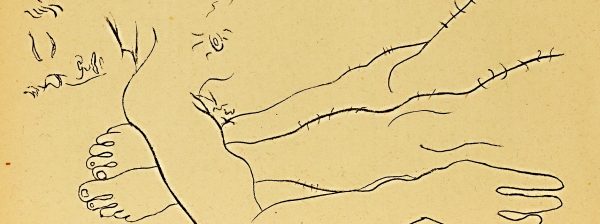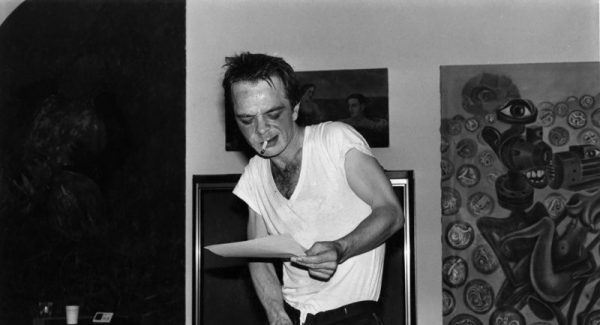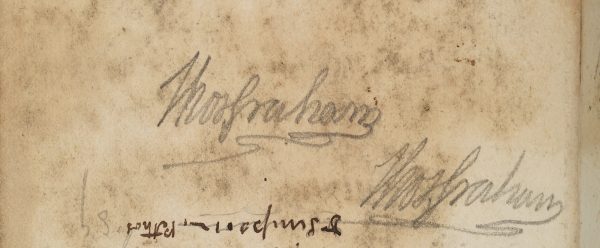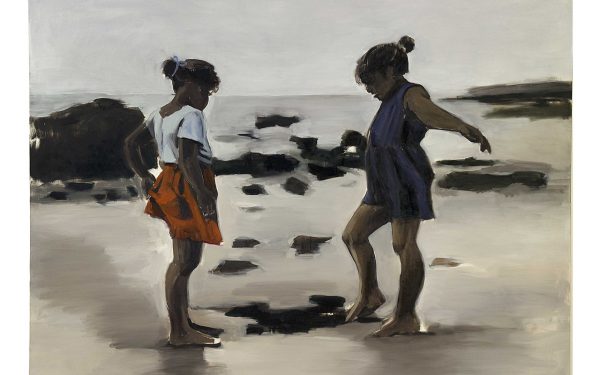‘1932. Spain at the time was over-run with vermin, its beggars. They went from village to village, in Andalusia because it’s hot, in Catalonia because it’s rich, but the whole country was ripe for us. So I was a flea, and well aware that I was one. In Barcelona we preferred calle Mediodía and calle Carmen. Sometimes six of us would sleep on a mattress without sheets and we’d beg in the markets from dawn. A gang of us would leave the barrio chino and spread out along the Parallelo, carrying baskets, because housewives were more likely to give us a leek or turnip than a few cents. At midday we’d go back and make soup with what we’d collected. I am going to describe the customs of that vermin.’ Jean Genet, The Thief’s Journal
* * *
After his descent into abjection, Genet decides to embrace his condition and transform it into a supreme virtue. He rejects the hierarchy of values of a self-righteous society and turns it on its head: transmutes what is base into something noble and what is noble into something base. The process of inner subversion he initiated in Barcelona’s barrio chino will be long and haphazard, and finds expression over the next ten years in his first poetic, narrative works written in Paris’s La Santé prison. The young, poverty-stricken lad, brought up in an orphanage, without identity papers, throws himself into theft, prostitution and begging and strives to emulate a criminal’s inveterate hardness with the self-surrender of a man initiating himself in the arcane secrets of a mystic belief and its stony path to spiritual perfection.
Fleas, he writes in The Thief’s Journal, were the most visible sign of his worthlessness, as representative of his pariah status as the jewels that adorn aristocrats and the bourgeoisie are of their condition as beautiful people. Lovingly cherished rags and sores attract pity and transmute shame into glory in his inner being. A pride necessary to withstand the scorn of others, solid and resistant like a rock dividing the flow of a river thrives on his desire for self-abasement: his country will be the scum of the earth, and he will be its bard and its chronicler.
* * *
We cannot be entirely certain of the dates of Genet’s stay in Spain. Although he mentions 1932 in The Thief’s Journal, it is a fact that, after enlisting in the army for the first time when he left the Mettray reformatory and was sent as a ‘colonial janissary’ to Syria in 1930, from where he was repatriated the following year, only to enlist once again and be dispatched to the Seventh Regiment of indigenous troops in Meknés, where he stayed until January 1933. Neither Edmund White’s exhaustive biography nor the time-line established by Albert Dichy define exactly the period he stayed in Spain. It was probably from November 1933 to April 1934. The only documentary proof is the letter he sent to André Gide on 12 December 1933 where, after describing his disastrous financial state (‘I’m totally broke in Barcelona, the consul is unapproachable, I’m an orphan and tramp from bar to bar.’), he asks for help and gives his postal address as the city’s poste restante.
After his initiation into the hunting ground of Barcelona’s old Fifth District, Genet’s career as a petty thief continues, first in Central Europe and then in France, until his first works, written in prison, are published in the mid-1940s. A brief review of his court sentences, reproduced in Jean Genet: Essai de Chronologie by Albert Dichy and Pascal Fouché, reveals how his youthful fascination for crime and devotion to professional crooks only led him to rival their deeds in an extremely modest manner. Together with the ‘crimes’ of vagabondage – the equivalent of the horrendous Spanish Law on Vagrants and Delinquents – the lack of an anthropometric identity card or his attempt to travel by train using a fake soldier’s pass, we can read: the theft of a dozen handkerchiefs from La Samaritaine department store, of signed copies from a bookshop on the rue Bonaparte, of a silk shirt from the Louvre stores, of a remnant of bed linen material from the Bazar in L’Hôtel de Ville, of a wallet and suitcase, et cetera.
Nonetheless, his failed career as a thief led him to his status as a great writer: he became that literary dynamite discovered by Cocteau and whose subversive power would soon astonish and shock Sartre.
* * *
Behind the Parallelo there was a nondescript area where crooks played cards. (The Parallelo is an avenue in Barcelona that runs parallel to the famous Ramblas. In between these two very wide streets, a large number of narrow, dark and dirty streets makes up the barrio chino.)
With these words, that could easily come from a pocket guide for tourists, Genet takes us into what will from now on be his ‘moral territory’ – theft, male prostitution, betrayal, humiliation, extreme poverty – always linked to Spain and his experience of initiation in Barcelona. His apprenticeship in evil, led by the left hand of the one-armed Stilitano, his mentor, is that of a petty thief with little know-how and even less profit: thefts from church collection boxes, small-scale fraud, requesting from his consulate a voucher to travel to the frontier that he will sell in the Estación de Francia, and prostitution with foreign sailors for a handful of pesetas. His boldest act remains the theft of a short cape from a policeman on the quays in the port. After satisfying the latter’s desires in his sentinel post, he takes advantage of the moment he goes to wash in a nearby fountain to grab the garment, wrap it round himself and run back to his lair in the barrio chino. This modest feat impresses his mentor, to whom he entrusts the sale of his booty as proof of his devout submission. (The tricked port policeman will pursue him in La Criolla but, warned in advance of the danger, Genet ‘does a Parallelo’ and disappears from that bar for some time.)
* * *
Outside the walls of the reformatories where he was interned as an adolescent and the barracks where he subsequently enlisted, Genet finds in the turbulent Spain of that era the place to inaugurate his adventure in morality and aesthetics. Barcelona’s barrio chino – the present-day Raval – was the ideal haunt for the dregs and detritus of society. The ‘livery of misery’ that the Spanish classics refer to ironically – namely, rags, filth and rope sandals worn down to the sole – identify the brotherhood of beggars and pickpockets that camp out there. The gallery of Genetian characters – con-men, small-time crooks, prostitutes, beggars, deserters and transvestites –, burrowing away in the nooks and crannies of that space, as people used to seek out sacred havens, are not so very different from the underworld in Seville that Cervantes knew so well. The holy aura of the vilified Fifth District guides Genet, as we shall see, along the paths to his strange sanctity.
The Genet of the Ramblas, the spurious son of the Parallelo, heads into a territory of shame determined to become an object of contempt and loathing, in search of inner purification that elsewhere I have compared to the malamatis of Islam that Ibn Arabi located in the highest sphere of the blessèd. He and his brothers in wretchedness parade through Spain, he says, ‘a secret, humble splendor entirely without arrogance.’ He focuses his energies on ‘giving sublime meaning to such a wretched façade.’ The moral solitude he longs for transforms his destiny into an unwavering consciousness that gives rise to a luminous, disturbingly unique work. His longing for a criminality condemned by society, allied with the desire to betray, acquire a hard, diamantine brilliance.
* * *
Genet’s admiration for the queens of Spain he encountered in Barcelona surfaced more than once in our conversations. They were the most daring and provocative in Europe, he would say, their natural reaction to the rejection they suffered. They faced up to the insults that were commonly aimed their way with a ritual of disguises, gestures and high-pitched screams that would go from the hysterical to the sublime.
When I went to the barrio chino for the first time in 1949 guided by a university friend as fond of books as I was and also a connoisseur of the city’s seamier side, La Criolla and bars where that species of the damned once reigned had disappeared. The web of narrow streets stretching from the Portal de Santa Madrona to the calle del Carmen harbored a handful of brothels at five pesetas a token and the predominant wretchedness can’t have been very different from what Genet experienced. Madame Petite’s renowned knocking-shop, which possibly inspired him when he wrote Querelle de Brest, Madame Lysiane’s Fair was a shadow of its former self and the progeny of those who were publicly vilified (and privately appreciated by some) hid their face-paint, fans, combs and flamenco flounces from the eyes of ‘decent’ citizenry.
A photo recently published in El País of two transvestites prowling around the Ramblas, in the early hours, on the hunt for a drunken tourist to rob brought to mind a passage in The Thief’s Journal where two tarted-up mariconas, with wonderful eyes and huge eyebrows, are walking in the vicinity of a Vespasienne (as the French dubbed the circular metal public urinals in France mercilessly demolished by Mayor Chirac) carrying a trained monkey on their shoulders. At a sign from one of them, the monkey would jump on the most bourgeois looking pick-up and, in the confusion, steal his wallet.
The funeral cortège of the so-called Carolinas (courageous precursors of the Parisian gasolinas of May ’68) to the site of one of the toilets destroyed in the street disturbances in 1933 is one of the most beautiful moments in The Thief’s Journal:
It was near the port and barracks, and the urine of thousands of soldiers had corroded the cast iron. When its death was proclaimed, the Carolinas, wearing shawls, mantillas, silk dresses, tight-fitting jackets – not the whole crew but a specially selected solemn delegation – came and laid there a bouquet of red roses tied in veil of black crepe. The cortège left the Parallelo, crossed calle Sao Paolo, went down the Ramblas de las Flores, as far as Colombus’s statue. There were perhaps thirty or so pansies, at 8 am, as dawn broke. I watched them walk past. I accompanied them at a distance. I knew my place was in their midst, not because I was one, but their raucous voices, cries and way-out gestures, I felt, had a single goal – to break through the layers of contempt expressed by the world at large. The Carolinas were magnificent. They were the Daughters of Shame. After reaching the port, they veered right, to the barracks and laid down the flowers on the rusting, stinking cast-iron of the demolished public lavatory.
What genius of a director will one day film that scene with the beautiful precision of a Visconti and cruel humour of a Fassbinder? The tragicomic heroism of the Carolinas deserves to be remembered and included in the breviaries of a new form of sanctity at the antipodes of Monsignor Escrivá and the founder of the Legionaries of Christ the King. Genet always reproached himself, he told me, for his lack of courage. He stayed in the ironic, indulgent crowd that welcomes its mourning rather than taking up the honorable place that belonged to him.
* * *
One of the most beautiful pages of The Thief’s Journal describes the episode of the tube of Vaseline. Arrested in a round-up and taken with other suspects to the district police station (I can imagine the scene very clearly, because the poet Jaime Gil de Biedma and I had the same misfortune at the end of the 1950s, when we roamed around the cross roads of San Pau and Robadors late at night), the policeman frisking Genet removed from his pocket the lubrication he used for anal penetration (that I also used to take with me on my first forays into Barbès and the Gare de Nord): a tube that’s been used up, the mere presence of which is clear proof of his membership of the guild of the mariconas (Genet always uses this Spanish word, aware of its brutally pejorative burden):
In the midst of the elegant objects taken from the pockets of the men caught in the round-up, this was a sign of abjection itself, the sort that takes great care to keep out of sight, but also the sign of a secret grace that would soon save me from scorn […]. I knew that all night my tube of Vaseline would be an object of the policemen’s derision – the opposite of a Perpetual Adoration […]. However I was sure that this humble, fragile object would resist them and, its mere existence would defeat police forces throughout the world.
Invulnerable to insult – I am reminded of the T.E. Lawrence’s ‘I’m completely dead to decency’ – the comparison of the palpable evidence of his shame with the Holy Sacrament allows Genet to invigorate and enhance his beggar’s life in the barrio chino, and subsequent meanderings in Cádiz and San Fernando, through recourse to the noblest, most sacred terms. His verbal victory thus leads him to hallow the misery inspiring him and drawing him to a new form of moral perfection:
The greater my guilt in your eyes, something I entirely embrace, the greater my freedom and the more perfect my solitude and singularity.
* * *
The encounter with Stilitano, the Serbian deserter from the French Foreign Legion, marks a before and after in Genet’s life and is the first link in a chain of successive infatuations with crooks or individuals from the underworld – the Harcamones, Bulkaen, Maurice Pilorge, etc. – that were elevated by him to the altar of excellence and glory. He dedicates his first thefts in the barrio chino to Stilitano’s awesome strength and lack of shame, to the uniqueness of his amputated right arm and hand that lay rotting under a chestnut tree in a forest somewhere in central Europe. The strength irradiating from this stump arouses in him an attraction similar to the one he experiences forty years later for the Sudanese Mubarak in a Palestinian refugee camp, when he asks him to hold his cigarette while he unbuttons and quietly urinates next to him: the guttural tone of his voice belongs in both to that of an erect sex.
Stilitano’s character encompasses the rigor of the soldier, adventurer, assassin and crook. Although he allows physical intimacy with Genet – both sleep in the same bed in a cheap hotel in the district – he refuses him sex. He has contempt for mariconas and occasionally pimps. Nonetheless, to attract the former and prostitutes, he safety-pins a bunch of balls of cellulose wrapped in cotton wool inside his flies, so that it swells and stands out in a gesture of pure provocation. Genet is responsible for the task, and can’t stop his hands from trembling as he does up and undoes the bundle at the beginning and end of each day’s snooping and bartering. One day, rather than leaving it on top of the stove, as usual –
I couldn’t resist holding it in my hands and lifting it to my cheeks. Stilitano’s face, above me, hardened. ‘Let go, you bastard.’ I had crouched down to open his flies, but Stilitano’s rage, as my customary eagerness wasn’t enough, made me fall on my knees, in the position that I mentally longed for. He hit me with both feet and one fist. I could have run off but I stayed.
His subsequent betrayal to the police of a common friend, Pepe the Gypsy, for the murder he committed in the vicinity of the Parallelo doesn’t tarnish Genet’s devotion towards him: on the contrary, he tells us, it lavishes upon him all the luminous attributes of betrayal.
* * *
Genet’s numerous references to La Criolla, the cabaret where he prostituted himself out of devotion to Stilitano, give no indication as to whether it was located in the barrio chino neither do they include a description of the bar. Nits de Barcelona, published in 1931, that is, two years before Genet arrived in Spain – a work recently re-published by Proa, with the original Oleguer Junyent illustrations and Josep M. De Segarra prologue – pinpoint what is missing and supply valuable information. The author, Josep M. Planes, contributor to the splendid magazine Miradorand a compulsive night-bird, was murdered on 24 August 1936 on the Arrabassada by out-of-control FAI gunmen about who he had written rather unfavourably weeks before the military uprising against the Republic. Segarra sketches in a suggestive description of his own and agrees with Planes’s acute perception of the city in the period from Primo de Rivera’s dictatorship to April 14 and the declaration of the Second Republic: ‘The people who most profit at night in Barcelona are tourists, thieves, poets, prostitutes, people who don’t have a cent and people who have bucketfuls.’ Planes writes:
La Criolla– is in the middle of calle del Cid. The luminous sign that hangs down over the façade and blurs the poor city landscape with a reddish glow […], buildings and people share the same air of wretchedness and you never know whether the filth on the walls comes from the men and women leaning on them or vice versa […]. The rabble gathered on the road and the prostitutes and inverts flaunting themselves on the pavements float against this vermilion backdrop, as decorative and stylized, as in the illustrations that Francis Carco must dream about for his books.
The calle del Cid (how ironic – the name of the Cid, preserved to this day, on what remains of the street, between the Parallelo and the avenue of Les Drassanes!) is at the time full of rubbish, soldiers, prostitutes, sailors and beggars. Any thief with a knife can suddenly take out his seven-bladed tool and assault well-heeled passers-by who look in his direction. The establishment of La Criolla, an old textile factory converted into a cabaret, drapes across the austere nakedness of its columns a lurid décor of palm trees with fake green leaves, coconuts, monkeys and blacks from Tarzan comics that confers a down-at-heel tropical splendor. A tango orchestra occupies the scenario, deafens the clientele and injects its fever into the couples on the dance floor.
(Genet evokes in his The Thief’s Journal the tune of Ramona but not the voice of Irusta – the trio in fact formed by the latter with Fugazot and Demare – mentioned by Planes, whose backstreets music was the great hit of the pre-Civil War years. As a child I listened to the song mentioned by Genet on an old wind-up gramophone with an external speaker – I know the words by heart – and the records of that Argentine trio that was the rage at the time, either ahead of Carlos Gardel or following in his footsteps. My retrospective familiarity with La Criolla is thus reinforced. Its musical repertoire lulled my ears in the ‘decent’ Barcelona of the city’s upper reaches.)
When Planes sketches in his portrait of the cabaret, he points to the existence, on the pavement opposite, of Cal Sagristá, a bar famous, he says, for its ‘inverts’ – respectable people of the time used that nasty word – how far we are from the era of gay identity! –, to which young lip sticked, sleek-haired men would repair. Strangely, Genet makes no mention of it.
The refurbished calle del Cid currently has none of the filth and din it had seventy years ago. When the Barcelona Town Hall gave the writer’s name to a small square or garden the other side of Drassanes. I was invited to say a few words in the naming ceremony. I hardly need to say that I didn’t accept: I was afraid an angry Genet might resurrect from his tomb in Larache and bury me under an avalanche of sarcasm and insults. His inverse perception of the terms of honor and dishonor is also mine. I prefer to go back to the cruel image with which Planes brings to a close the chapter: the deserted street at dawn after La Criolla has shut, a Goyesque vision of two horrendous old women and the three-cornered hats of two Civil Guards on patrol.
* * *
The thefts and petty crime that provide for Genet and Stilitano are not enough to save them from poverty. Although the future author of The Thief’s Journal gives his ‘protector’ the few pesetas he earns or snitches in public conveniences, the latter tells him to prostitute himself in La Criolla. There, female garb is a must. Some of Genet’s Spanish friends run the joint and they give him the details of second-hand clothes sellers. If ‘it’s very difficult’ he writes, ‘to emerge in the light through the pus and sores of shame,’ the cabaret’s owner now requires him to parade himself ‘as a girl.’ Swallowing his blushes and changing them into a kind of dart aimed at those demanding such displays? Genet goes to La Criolla and is invited, with another transvestite, to the table of a group of French officers. The lady accompanying them asks in an exaggeratedly condescending tone if he fancies men, Genet resists the temptation to give her a slap and takes his revenge by filching a wallet from one of the military.
One of the most beautiful pages in The Thief’s Journal recounts events during the Carnaval, a time of year when it was easier to don disguises and draw attention to oneself. After stealing a flamenco dress and blouse, to which he adds the accessories of a fan and mantilla, Genet walks through the barrio chino on his way to the calle del Cid. As a last trench in his defense, he keeps his trousers on under his skirt. But, a moment after he arrives at the bar, the train to his dress rips. A young man has stumbled on his flounces and, however much he apologizes and says he has a limp, the would-be tragic actor howls ‘Don’t limp on my skirts!’ with a hysteria that erupts through the tough cortex of the world with the force of a geyser.
Humiliated, Genet leaves the dive to the laughter of customers and Carolinas. Although, when he re-reads the text, the author corrects his mistake and notes at the foot of the page that the episode happened in Cádiz, where he also prostituted himself using flamenco garb, the prestige of La Criolla emerges intact from his lapsus. The scene’s theatricality reaches a point where abjection and pride meld. The skirt, blouse, fan and mantilla he later hurls into the sea are part of an absurd ritual which gives the humiliated vagabond tramp the necessary strength to confront the cruelty and hypocrisy of a self-righteous society: yesterday’s, today’s and no doubt the one that will follow us with the passage of time.
Soon afterwards, Genet and Stilitano abandoned their haunts in Barcelona, took to a goods train and looked for a new refuge in Cádiz.
* * *
I was born in Paris on 19 December 1910. I was a ward of Public Assistance and never found out any more about my civilian status. When I reached the age of twenty-one, I obtained a birth certificate. My mother’s name was Gabrielle Genet. My father is not known. I came into the world at 22 rue d’Assas.
Although Maternité refused him all information on how he entered the world, the image of the hidden mother appears intermittently throughout Genet’s work. He clings to his surname, that Genêt d’Espagne or yellow broom with which Cocteau greeted his volcanic eruption into the world, and identifies with the vegetable world and considers, he will say, that all flowers belonged to his family. Through them, he compares himself to bracken flourishing in marshland and dreams of possible vegetable species on the planet Uranus, in a metempsychosis that changes him into a creeping crawling being, like the hoodlums on the Parallelo, with convicts of his race for sole company.
But this literary mauditisme bears no relation to his future rebellion against the established order, in both the social and political and artistic and moral fields. The absent mother becomes his departure point for his incursions into a literary territory that climax in his masterpiece, A Prisoner of Love.
In The Thief’s Journal, Genet evokes the image of an old beggar woman with an emaciated face and squat and round as the moon, who asks him for money. Her hypocritical, humble features lead him to believe she has just left prison. A pickpocket, he assumes, and he immediately associates her, in a fleeting daydream, with the woman who abandoned him in the cradle:
And what if it was her? I wondered as I walked away from the beggar-woman. If she was, I’d go and shower her with flowers and kisses. I’d shed tears of tenderness over her moon-fish eyes, over her obtuse, stupid face.
The vision of the mother of Hamza the fedayeen, with whom he stayed in the Palestine refugee camp in Irbid in 1970, is much more complex and elaborate. Younger than Genet, the woman who gives him the bed of her son, who is away on a combat mission in the territories occupied by Israel, tiptoes in with a cup of coffee, thinking he is asleep, and is transformed, like statues of the Mater Dolorosa, into the writer’s symbolic mother, who looks after him, as on that sacred night, throughout his life: a fantasy, he tells us, cherished from childhood, from when he was five years old.
The image of Hamza and their mother – his and the Palestinian guerrillero’s – superimposed like a transfer on the image of the Pietá and Christ the Crucified, subsequently link up with the Virgin carried in processions by the Maronites of the Lebanon and the Black Virgin in the monastery of Montserrat. ‘God, creator of heaven and earth, must have really enjoyed himself carving out those reddish, phallic rocks, Genet tells us, he who, as an old man, attended a celebration of Pentecost at the abbey, with music by a Palestrina who brought Palestine to mind. The abbot, he writes in A Prisoner of Love, kisses the faithful and he too accepts his double kiss but doesn’t pass it on to his neighbor, as is the custom, thus breaking the chain of fellowship.
In his correspondence with me at the time – removed by a compulsive kleptomaniac, who was nevertheless considerate enough to leave a photocopy, when it was being exhibited at the Town Hall in Almeria – describes his journey through late Francoist Spain, mocks the now bourgeois Barcelona and relates his pick up of a rent-boy, who, he says, is a sociology student, at the foot of Tibidabo. By this time, he is no longer the delinquent he dreamed of becoming forty years earlier but the voluntarily marginal writer who searches out first with the Black Panthers and later with the fedayeen the cause that will move him away from a France and Europe from which he has distanced himself for ever.
At the end of The Thief’s Journal, Genet announces a second part he never wrote: he intends, he says ‘to relate, lay bare, comment on the annals of the private prison where I found myself after crossing this inner space I have called Spain’. His youthful desire to fill the world with his abominable progeny gives way, after his stay in the Palestinian refugee camps in Lebanon and Jordan, to a return to his unknown origins. ‘This last page of my book,’ he writes in A Prisoner of Love – ‘is transparent. It is a transparency that lets through the light: his path to moral perfection via unpredictable turns and different ways to St John of the Cross and Mawlana the Sufi dervish, and one leading him to a subversive, pagan form of sanctity.




